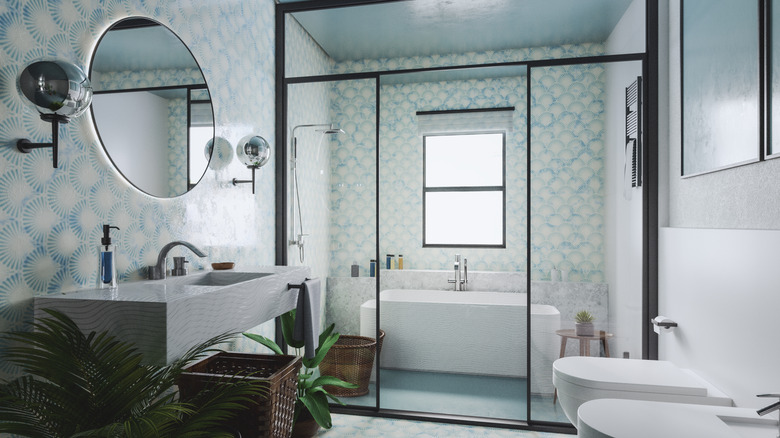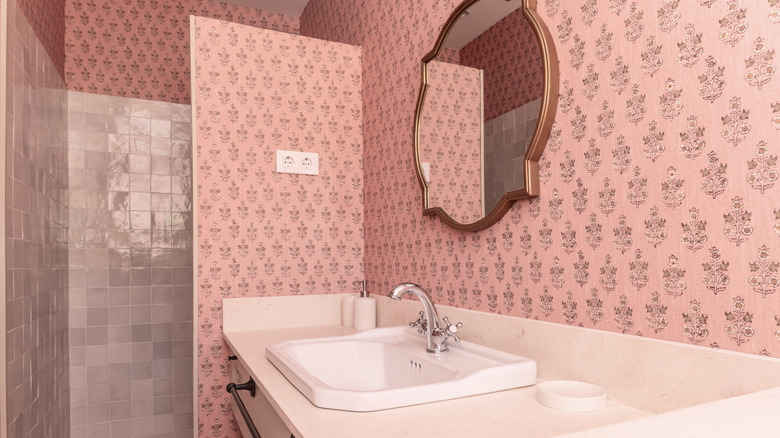How To Use Wallpaper To Mix Design Eras In Your Bathroom
Wallpaper is a simple, renter-friendly, and often affordable design hack that can elevate the style of a room, regardless of what interior you're going for. Patterned wallpaper can add depth to a bohemian space, while incorporating paper with muted colors can be a minimalist's dream. When it comes to giving your bathroom a stylish makeover specifically, you may want to add wallpaper to add visual appeal while also making it cozy and inviting. And with so many eras of style to choose from, you don't have to be married to the time period displayed by the elements in your space — you can create contrast by using a wallpaper from a different era. For example, you can blend eccentric bohemian wallpaper patterns reminiscent of the '70s with modern fixtures and furniture, or vice versa, and add texture to your home decor. To do this, you first need to decide what era your bathroom is, then choose a wallpaper that pairs well with it.
Mixing and matching design eras can add depth and individuality to your bathroom, which works if you find it to be dull and want to make it more interesting by blending elements from different periods. In order to mix and match eras tastefully, you'll need to determine your bathroom's current style. What about your bathroom's design speaks to your personal style the most, and what elements of those styling choices do you want to be accentuated? From there, you can choose a wallpaper from a different time period based on the style of your bathroom.
Choosing the right wallpaper based on your bathroom's design
Using a wallpaper pattern from a different era than the style of your bathroom is contingent on the furniture and fixtures in that room. For this reason, it's important to consider the elements of your bathroom where the wallpaper will be layered over, such as fixtures, tiles, lighting, and windows. Is your bathroom contemporary, with sleek lighting and modern sinks and showers? If so, you may want to mix up the designs with vibrant colors and patterns to add depth and visual intrigue. If your bathroom has traditional and rustic features, such as a single basin cabinet that reflects the utility and style of the early 20th century or a 19th-century style clawfoot tub, you can mix modern neutrals and muted wallpaper patterns to balance the styles out.
Mixing patterns in your home decor using wallpaper requires studying architectural design elements that were culturally relevant to different periods. For example, you may learn that minimalism, which emerged in the '60s and is hallmarked by its sleek and practical style, uses overly simplistic patterns or bare walls, but it can blend well with art deco elements made popular in the '30s. Architecturally, these styles are different, but the opulence of the '30s, including antiques and geometric patterns, can lie nicely against the neutral colors and clean lines of a minimalist bathroom design.
Unifying your space and what to avoid
Similar colors, patterns, and textures throughout your bathroom and the wallpaper you choose can unify the space. For example, if your bathroom has mid century modern decor like gilded mirrors or geometric tiles, you may consider employing 18th-century farmhouse wallpaper designs, such as florals and twigg roll. Choosing similar colors can help tie the two eras together even further.
Another thing to consider when mixing and matching eras is the details. Adding elements to your bathroom that are present in your wallpaper can tie the room together. For example, gold accents and rich textures were prominent in the Gilded Age and can work well against a floral wallpaper from that era when layered against the modern architectural elements of a bathroom.
However, avoid mixing eras that are too contrasting. The Victorian era's grandiose Dahlia scroll pattern, for instance, may overwhelm the elements of an art deco or mid century modern style bathroom. Furthermore, using a wallpaper color that contrasts too much with your bathroom might make it feel out of place. Therefore, if you have pink tiles from the '50s, don't pair them with something that draws too much attention, like a maximalist neon wallpaper design.


